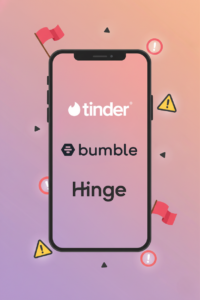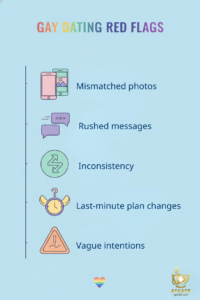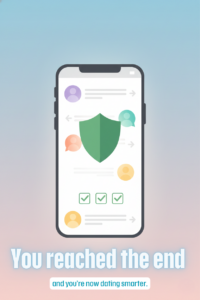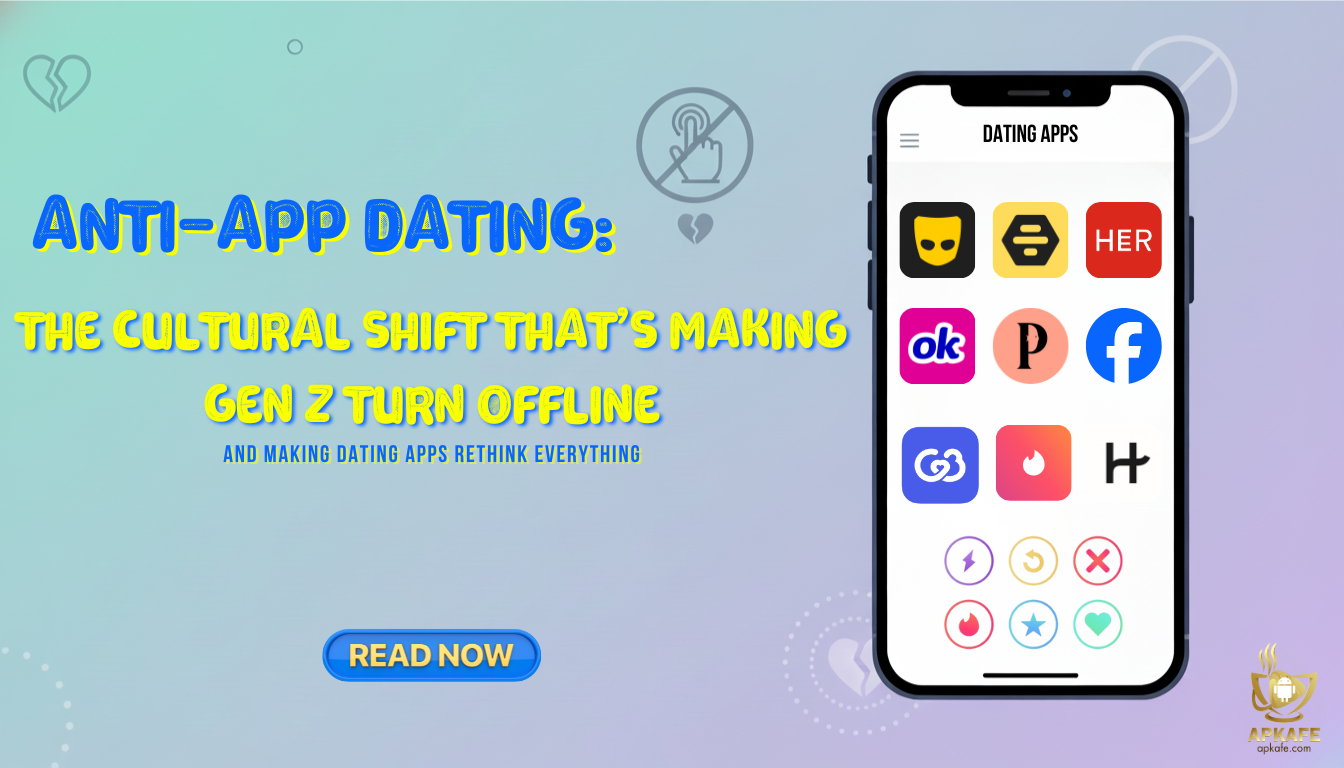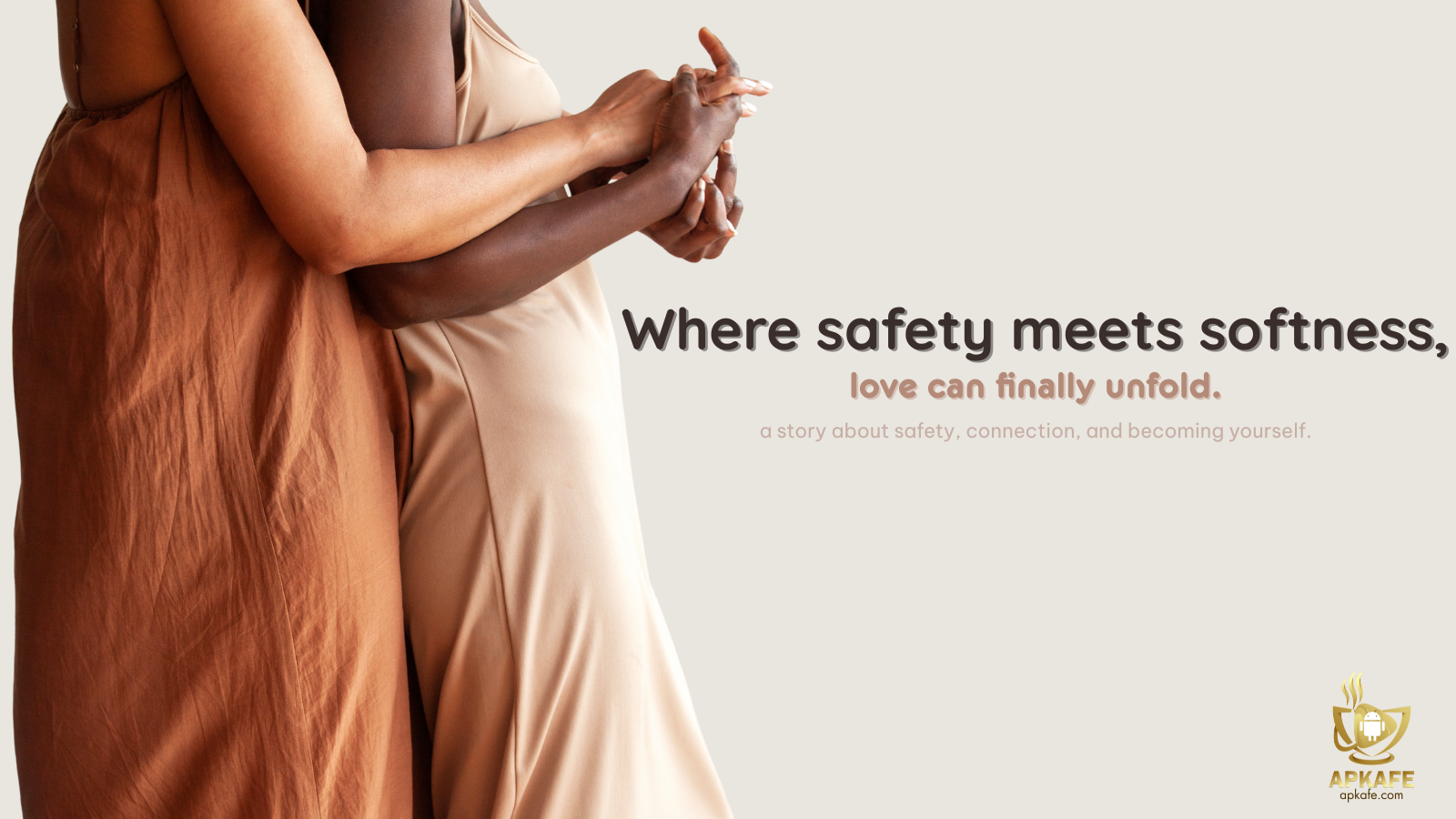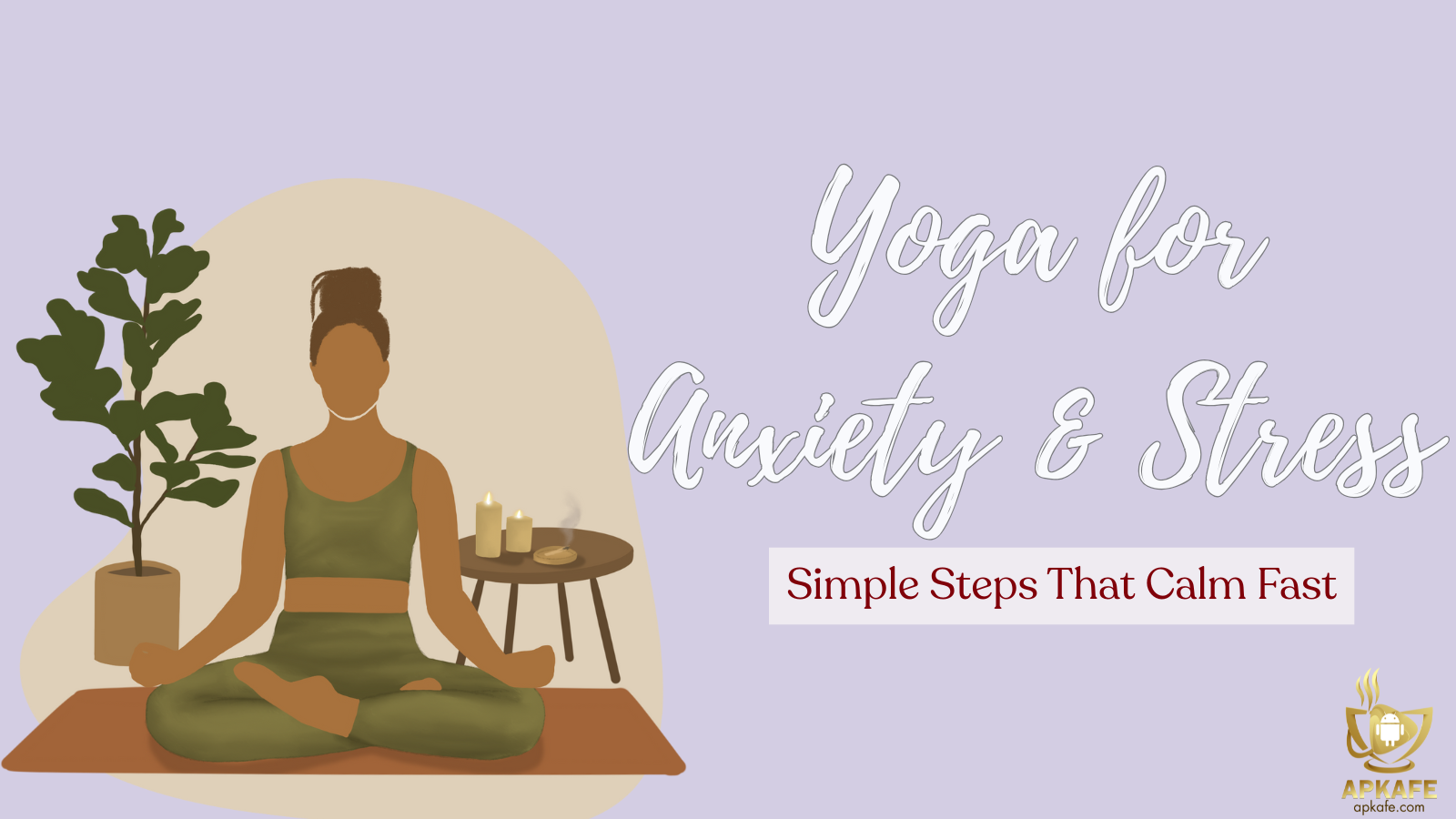How to Spot Gay Red Flags on Grindr, Hinge & Tinder (US Guide)
Gay dating apps move fast, and red flags often appear long before a bad date does. This guide breaks down the most common warning signs on Grindr, Hinge, and Tinder—from profile inconsistencies to chat behaviors and meeting logistics—so you can filter smarter, stay safer, and connect with people who match your intentions.
👀 Have you ever matched with a guy who seemed perfectly normal—great photos, friendly vibe—but something small made you pause?
🔍 And did you ever wish there were clear signs, almost a hidden code, that could help you avoid the wrong people faster?
If so, you’re not alone. Gay dating apps move fast, the signals aren’t always obvious, and sometimes your intuition picks up what logic can’t.
The good news? 🚦 Red flags on Grindr, Hinge, and Tinder follow predictable patterns—and once you learn them, you’ll spot trouble (or low-intent matches) in seconds.
✨ By the end of this guide, you’ll navigate dating apps with far more clarity, confidence, and emotional safety.
Let’s break everything down in a way that feels practical, human, and actually usable.
What “Red Flags” Mean for Gay Dating in 2025
✨ Understanding the landscape helps you see people more clearly and protect your emotional energy.
Gay dating is evolving fast—sometimes faster than the rules we rely on. Apps are bigger than ever, anonymity is easier than ever, and expectations can shift from casual to serious within a single conversation. This creates confusion, mixed signals, and plenty of moments where you wonder whether something feels “off.”
A 2024 LGBTQ+ safety survey found that 📊 37% of queer app users encountered a fake profile or misleading identity, and ⚠️ 29% felt unsafe during at least one in-app conversation.
These numbers aren’t meant to scare you—they simply confirm your intuition is valid.
If you want a positive contrast (the green signs instead of the red), explore:
👉 10 Green Flags You Should Not Ignore
Red flags aren’t about judging people. They’re about protecting your time, your values, and your emotional safety.
Why gay dating apps create unique patterns
Gay men face distinctive challenges on apps:
🕶️ Higher anonymity
📍 Location-driven matching (especially on Grindr)
⚡ Fast expectations (hookups vs. dating)
🤐 Fear of being outed
🎭 Identity blending (travel mode, closeted users, inconsistent profiles)
These factors create red-flag signals that don’t show up the same way in straight dating spaces.
💭 A Question to Help You Reflect Before You Swipe Further:
“Has your intuition ever warned you about someone—even when their profile looked perfectly normal?”
Sometimes the smallest detail is the loudest signal.
Step 1 — Profile-Level Red Flags (Before You Even Match)
✨ The faster you filter, the more time and energy you save for people who actually match your intentions.
Profile red flags often reveal themselves instantly if you know what to look for. Most bad experiences start here—not because people are bad, but because their intentions aren’t clear or consistent.
1️⃣ Blank or Nearly Blank Profiles
This is extremely common on Grindr—a faceless torso pic, no bio, no details, no clear intent. Sometimes it’s privacy; sometimes it’s deception; sometimes it’s trolling.
📘 Micro-story:
A guy in Los Angeles shared he kept seeing the same blank profile appear at “0 ft away” in different neighborhoods. It turned out someone was spoofing GPS while looking for quick hookups.
Not illegal, but not what most daters want.
🤔 Questions to ask yourself:
- Do I actually know anything about this person?
- If the app lets them share something, why choose to reveal nothing?
2️⃣ Photos That Don’t Match Each Other
Common inconsistency signals:
- Three pictures in the same outfit → likely pulled from social media
- Face photo looks 5–7 years younger than body photo
- Lighting, shadows, or angles don’t match
- Resolution jumps drastically across images
You don’t have to be a detective. Inconsistency alone is enough to take things slowly.
3️⃣ Bios That Say Nothing (or Everything Generic)
Especially common on Tinder and Hinge.
Examples of low-effort bios:
- “Ask me anything”
- “Work hard, play harder”
- “Looking for good vibes”
- Prompt answers that feel copy-pasted
This doesn’t make someone unsafe, but it signals something important:
They’re not investing effort—which often reflects their dating behavior.
If you want to study good signs too, here’s the positive counterpart: 10 Green Flags You Should Not Ignore — The Signs That Actually Matter
4️⃣ Information That Doesn’t Add Up
Watch for inconsistencies:
- Different ages across apps
- Vague job descriptions (“Entrepreneur” with no details)
- Travel-mode ambiguity (“Just in town tonight”)
- Height or weight changing between profiles
If the information confuses you, that confusion itself is a red flag.
❓A Key Question to Help You Evaluate Profiles:
“If this person showed you this exact information in real life, would you trust it enough to meet them?”
Step 2 — Chat Red Flags (Usually Appear in the First 4 Messages)
✨ You deserve conversations that feel respectful, stable, and predictable—not chaotic or draining.
Chat red flags often show up almost instantly because people reveal their communication patterns faster than they realize. The first few messages can tell you whether someone respects boundaries, communicates clearly, and has compatible intentions. A smooth beginning saves you emotional energy later.
If chat anxiety makes it hard for you to set boundaries or ask for clarity, this guide may help:
👉 How to Fix Messaging Anxiety on Dating Apps
1️⃣ “Send pics?” as the first message
There’s nothing wrong with wanting attraction—but when someone leads with a request (or demand), especially a sexual one, it reveals boundary issues rather than interest.
📘 Real example:
A user in Seattle shared that a guy opened with: “Hey. Send a body?”
When he politely declined, the guy ghosted instantly.
That’s not rejection—it’s self-filtering. You dodged the wrong match.
2️⃣ Rapid mood shifts
If someone gets cold, irritated, or passive-aggressive simply because you didn’t reply for 11 minutes, that’s not “preference”—it’s volatility.
You’re not responsible for managing a stranger’s emotional instability.
Early emotional swings often predict future communication problems, especially when stress or conflict arises later.
3️⃣ Pressure to move off the app immediately
If someone insists on switching to Snapchat, Telegram, or Instagram right away, pause and ask yourself why. Most often, it’s because:
- They want to avoid in-app moderation 🔒
- They prefer disappearing messages
- They want to send or receive sensitive content
- They want to remain untraceable or anonymous
Moving platforms too quickly can compromise your safety, boundaries, and comfort.
❓A Key Question to Ask Yourself:
“If someone is genuinely serious—or even respectfully casual—why would they rush you off the safest, most moderated space?”
A person who respects your pace will have no problem staying on the app a bit longer.
4️⃣ Overly intense compliments too soon
Fast flattery may feel good, but speed is the real red flag.
Examples include:
- “You’re perfect.”
- “You’re exactly my type.”
- “I can’t stop looking at your photos.”
Flattery isn’t harmful—but when it’s too early, too strong, or too frequent, it can signal:
- idealization
- manipulation
- lack of emotional grounding
- or someone projecting a fantasy onto you
Healthy attraction grows; it doesn’t rush.
Step 3 — Logistics & Meeting Red Flags
✨ The decisions you make in the last 10 minutes before a meetup often determine whether the experience feels safe, smooth, and respectful.
You’ve made it past the profile and early chat—great.
But meeting logistics is where many people ignore red flags because excitement takes over. This is also the stage where your safety and comfort matter the most. Paying attention here saves you from awkward or unsafe scenarios later.
1️⃣ Changing Plans Repeatedly at the Last Minute
A small change is normal—life happens.
But when someone changes the meetup location multiple times, especially within minutes of meeting, that’s unpredictability, not spontaneity.
Common patterns include:
- “Let’s meet at this café.” → “Actually, meet me in this parking lot.”
- “I’m almost there.” → “Wait, can you come to my place instead?”
- “Let’s meet downstairs.” → “No, just come inside.”
Frequent last-minute changes signal a lack of respect for your time and comfort.
💬 Micro-story:
A reader in Miami shared that a guy changed the meeting spot three times in 12 minutes.
Each new location was more isolated.
He canceled—and later learned the guy was doing this with multiple users to test who’d agree.
2️⃣ Refusing a Quick Video Check
A 15–20 second video call (or an in-app selfie verification) is standard in 2025.
It’s fast, simple, and prevents most catfishing or mismatched expectations.
If someone strongly refuses or gets defensive:
- Are they hiding their appearance?
- Do the photos not match reality?
- Is this a duplicate or stolen account?
- Are they anxious about being recognized by someone nearby?
Some reasons are innocent—but the avoidance itself is a signal.
A respectful person will understand why video verification matters.
3️⃣ Wanting to Meet in Private Right Away
Not everyone who invites you to their place is dangerous—but it’s a contextual red flag when:
- You haven’t talked long
- They refuse public meet-ups
- They pressure you to come over
- They avoid sharing basic details
- They don’t want to meet halfway
Private locations reduce visibility and control. If you’re not actively seeking a hookup, a home invitation too early is a mismatch in expectations—not a vibe you owe anyone.
💬 Micro-story:
A guy in Chicago said someone insisted he come over for “just a drink,” yet wouldn’t give the unit number until he was in the lobby. A small detail—but his gut said no.
He left.
Later, he found out multiple people reported similar experiences.
❓A Key Question to Help You Stay Grounded
“Does this meeting setup make me feel in control, or am I giving up control to someone I barely know?”
Your comfort level is the clearest indicator of whether to continue or walk away.
Step 4 — App-Specific Red Flags (Grindr, Hinge & Tinder)
✨Each app has its own “risk signature.” Knowing these patterns helps you filter faster and avoid mismatches early.
Different platforms shape different behaviors. Here’s a lean, practical breakdown of what to watch for across the top three gay dating apps.
If you’re still deciding which app fits your intentions best, you may find this useful:
👉 Top Dating Apps for Gay Men (US)
Grindr — Fast, Anonymous, Proximity-Based Red Flags
- No face + instant pressure: “Host?” or “Come over?” within seconds reflects rushed expectations.
- Distance spoofing: Someone always showing “0 ft away” may be using GPS tricks.
- Link drops: Early OnlyFans or Telegram links usually indicate non-dating intentions.
Short micro-story:
A Houston user said someone messaged “host now?” 12 seconds after viewing his profile.
Hinge — Effort, Prompts & Authenticity Red Flags
- Copy-paste prompts: Generic answers signal low effort.
- Voice note mismatch: If the voice feels out of sync with the photos, trust that instinct.
- Minimal photos: Only 1–2 pics suggest low investment or privacy concerns.
Tinder — Aesthetics, Ambiguity & Travel Mode Red Flags
- Over-edited photos: Pinterest-like images can signal unrealistic presentation.
- Unclear intentions: Avoiding the “what are you looking for?” questions can lead to confusion.
- Hidden travel mode: Visitors often don’t mention they’re only in town briefly.
Short micro-story:
A San Francisco user matched someone “local,” then saw the same profile active in three cities within 48 hours.
❓A Quick Gut-Check to Guide Your Decision:
“Does this person’s overall behavior feel transparent and consistent—or do you find yourself filling in the gaps for them?”
This one question helps you assess Grindr, Hinge, or Tinder red flags more accurately than any single detail.
Step 5 — How to Respond to Red Flags Without Drama
✨ Boundaries aren’t about confrontation—they’re about protecting your emotional bandwidth and keeping the interaction healthy.
Even when you spot a red flag early, responding can feel awkward. The goal isn’t to argue or “teach” someone. The goal is to communicate your limits calmly and move on when needed. Small, confident responses can prevent stressful conversations later.
1️⃣ Use a Clear, Calm Boundary Statement
When something feels off, a simple boundary often tells you everything about the other person’s intentions.
Examples of neutral, non-confrontational lines:
- “I prefer staying on the app for now.”
- “I’m not comfortable sharing photos that quickly.”
- “Let’s slow down a bit—I like getting a basic sense of someone first.”
People with genuine intentions won’t feel offended.
2️⃣ Offer a Path Forward (If You Want To)
If you’re still open to talking, add a gentle invitation:
- “Happy to keep chatting here if that works for you.”
- “If you’re okay with taking things at a normal pace, I’m happy to continue.”
Effective boundaries don’t shut people out—they clarify the terms of interaction.
3️⃣ If They Push Your Boundary, That Is the Answer
Anyone who:
- argues
- guilt-trips
- pressures
- or ignores your boundary
…is revealing a behavior pattern you don’t need to manage.
Micro-story:
A reader from Denver once said he calmly declined sending off-app photos.
The other person replied with: “Wow, you’re dramatic.”
He unmatched immediately—later realizing he’d avoided a person who would’ve disrespected bigger boundaries, too.
4️⃣ Know When to Unmatch or Block
You should end the interaction immediately if someone:
- becomes rude or dismissive
- repeatedly ignores your pace
- demands private details
- manipulates your comfort level
- pressures you into a different style of communication
Leaving is not dramatic—it’s just choosing safety and peace.
❓A Simple Question to Help You Decide What to Do Next
“If this is how they act now, would I feel comfortable dealing with a tougher situation with them later?”
This one question often gives you the clearest answer.
Step 6 — The Safety & Privacy Essentials
✨ A few simple habits can prevent most uncomfortable or unsafe situations.
You don’t need a long checklist—just the core habits that keep you grounded and in control.
1️⃣ Meet in Public First
Choose a visible, comfortable location.
If someone pushes for a private meetup right away, that’s a signal.
2️⃣ Tell a Friend Your Plan
Share who you’re meeting and where.
It takes seconds, but adds peace of mind.
3️⃣ Keep Personal Info Private
Don’t share your address, workplace, or sensitive photos early on.
4️⃣ Verify Before You Meet
A quick selfie prompt or short video call eliminates most risks.
5️⃣ Stay in Control of Transportation
Arrive and leave on your terms so you can exit anytime.
Micro-story:
A Boston user trusted his gut when a date’s behavior felt “off” at the first meeting spot. He left immediately—and later learned major details had been lied about.
For a deeper breakdown, read:
👉 Safety Dating Checklist
Common Mistakes When Spotting Red Flags
Motivation: Stop blaming yourself; clarity helps you date smarter.
- Over-focusing on looks instead of behavior
Attraction is important, but behavior reveals someone’s character.
- Being scared to ask basic questions
Asking “Where are you from?” or “What are you looking for?” is normal.
- Ignoring inconsistencies
If something doesn’t add up, take it seriously.
- Thinking you’re “too sensitive”
You’re not. You’re paying attention.
FAQs: Gay Dating App Red Flags on Grindr, Hinge & Tinder
❓ Are red flags different across apps?
Yes.
Grindr = 🔥 fast + anonymous
Hinge = 📝 prompts reveal inconsistency
Tinder = 🌍 mixed intentions
❓ What’s the biggest overall red flag?
Lack of transparency about identity or intentions.
❓ How can I verify someone quickly?
A 10–20 sec video call or in-app selfie check works best.
❓ What if someone gets upset when I set a boundary?
That reaction is the red flag.
❓ What if I misread a red flag?
Genuine people won’t mind clarifying—your comfort comes first.
Conclusion — Your Key Takeaways & Next Steps
✨ Quick Summary
You now understand how to identify:
- profile red flags
- early chat warning signs
- unsafe meeting logistics
- app-specific patterns on Grindr, Hinge, and Tinder
- healthy boundary responses
- essential safety practices
These are the tools that help you date with clarity, confidence, and emotional protection.
💡 Insight to Remember:
Most red flags are quiet—not dramatic.
Pay attention to the small inconsistencies, and you’ll avoid the big problems.
📚 Want to Go Deeper? Here Are the Best Next Reads
👉 What Gay Guys Look for in a Partner
👉 How to Talk to Gay Guys on Dating Apps
👉 How to Find a Boyfriend as a Gay Man
👉 How to Date as a Gay Man in the U.S.
👉 Dating Safety Checklist for First-Time Users
💬 Your Turn to Share
What’s one red flag you now feel more confident spotting—and how has it changed the way you use dating apps?
User Reviews

